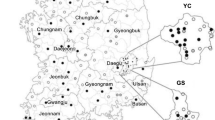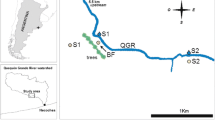Abstract
An inventory survey conducted to determine pesticide usage in a sub-catchment of the Nzoia sugarcane belt found a variety of pesticides used in the sub-catchment, which are reported in this paper. Analysis of soil samples from seven fallow experimental field plots left uncultivated for various periods from 3 to 96 months after cultivation with pesticide application indicated persistence of high concentrations of pesticide residues in the soil, with estimated soil half-lives (in years) ranging from 0.72 to 57.75 for organochlorines and from 1.13 to 8.25 for herbicides. The mean water concentrations (in μg/L) of the pesticide residues in River Kuywa, which flows through the Nzoia Nucleus Estate sugarcane farms, ranged from 0.12 (lindane) to 1.36 (p,p′-DDT) for organochlorines and from 0.14 (atrazine) to 1.75 (diuron) for herbicides during the heavy rains period in August 2008 while the mean sediment concentrations (in μg/g) ranged from 0.28 (lindane) to 1.87 (endrin) for organochlorines and 0.39 (hexazinone) to 4.61 (alachlor) for herbicides. The mean concentrations of residues in water during the light rain period in December 2008 ranged from 0.17 (p,p′-DDT) to 0.71 (aldrin) for organochlorines and 0.01 (atrazine) to 1.74 (alachlor) for herbicides while the sediment concentrations ranged from 0.38 (p,p′-DDT) to 1.145 (aldrin) for organochlorines and 0.74 (atrazine) to 1.98 (alachlor) for herbicides. Although DDT, aldrin, dieldrin, and endrin were not reported in the survey, their presence in the fallow experimental field plot soils and in River Kuywa water and sediment could indicate previous application, lack of recorded data or illegal usage since 1997 when they were banned. Notably, the concentrations of alachlor, diuron, cypermethrin, and hexazinone in the water column were substantial indicating their extensive usage and residual persistence in the sub-catchment, with subsequent wash-off and leaching into River Kuywa. The concentration levels of some of the individual pesticides exceeded the EU limit requirements for drinking water and indicated potential risk to humans and cattle if the water is used without treatment.

Similar content being viewed by others
References
Anonymous (2002) Bungoma District development plan (2002–2008), Bungoma, Kenya
Anonymous (2006a) Nzoia sugar company report, Nzoia, Kenya
Anonymous (2006b) The Kenya Sugar Board report 2005, Kisumu, Kenya
Bach M, Huber A, Frede HG (2001) Input pathways and river load of pesticides in Germany—a national scale modeling assessment. Water Sci Technol 43:261–268
Barlas NE (2002) Determination of organochlorine pesticide residues in water and sediment samples in Inner Anatolia in Turkey. Bull Environ Contam Toxicol 70:236–242
Bereket TY (2000) Distribution, fate and effects of 14C-DDT in model ecosystems simulating tropical fresh water environments. M.Sc Thesis, University of Nairobi
Berenzen N, Kumke T, Schulz HK, Schulz R (2005) Macro-invertebrate community structure in agricultural streams: impact of run-off-related pesticide contamination. Ecotoxicol Environ Saf 60:37–46
Chabeda PIM (1983) A survey of eutrophication and water pollution load in four rivers of the northern half of the Lake Basin Development Authority. Lake Victoria Basin Development Authority (LVBDA), Kisumu
Crawford CG (2004) Sampling strategies for estimating acute and chronic exposures to pesticides in streams. J Am Water Resour Assoc 40(2):485–502
De Snoo GR, van der Poll RJ (1999) Effect of herbicide drift on adjacent boundary vegetation. Agric Ecosyst Environ 73:1–6
Diaz R, Gaggia C, Sanchez-Hernanandez JC, Bacci E (1995) The role of soil and active ingredient properties in degradation of pesticides. A preliminary assessment. Chemos 30:2375–2386
EEC (1980) The European Union (EU) Drinking Water Directive (EEC 80/778)
Ellgard EG, Ochsner JC, Cox K (1977) Locomotion hyperactivity induced in the bluegill sunfish by sub-lethal concentration of DDT. Can J Zool 55:1077–1083
Eriksson P (1992) Neuroreceptor and behavioural effects of DDT and pyrethroids in immature and adult mammals. In: Isaacson RL, Jensen KF (eds) The vulnerable brain and environmental risks, vol 2. Plenum Press, New York, pp 235–251
Ewald JA, Aebisher NJ (2000) Trends in pesticide use and efficacy during 26 years of changing agriculture in southern England. Environ Monit Assess 64:493–529
Frampton GK (2002) Long-term impacts of an organophosphate-based regime of pesticides on field and field-edge Collembola communities. Pest Manag Sci 58:991–1001
Fry DM, Toone CK (1981) DDT—induced feminization of gull embryos. Science 213:922–924
Gladen BC, Rogan WJ (1995) DDE and shortened duration of lactation in a Northern Mexican town. Am J Public Health 85:504–508
Gonsalez M, Karim S, Julia E, Victor J (2003) Occurrence and distribution of organochlorine pesticides in tomato (Lycopersicon esculentum) crops from organic production. J Agric Food Chem 51:1353–1359
Haynes D, Ralph P, Pranges J, Dennison B (2000) The impact of the herbicide diuron on photosynthesis in three species of tropical seagrass. Mar Pollut Bull 41:288–293
Keng’ara FO, Getenga ZM, Wandiga SO (2004) Determination of organochlorine pesticide residues in soil and water from River Nyando drainage system within Lake Victoria Basin, Kenya. Bull Environ Contam Toxicol 72:335–343
Kreuger J (1998) Pesticides in stream water within an agricultural catchment in southern Sweden, 1990–1996. Sci Total Environ 216:227–251
Lalah JO, Kaigwara PN, Getenga ZM, Mghenyi JM, Wandiga SO (2001) The major environmental factors that influence rapid disappearance of pesticides from tropical soils in Kenya. Toxicol Environ Chem 81:161–197
Lalah JO, Yugi PO, Jumba IO, Wandiga SO (2003) Organochlorine pesticide residues in Tana and Sabaki rivers in Kenya. Bull Environ Contam Toxicol 71:298–307
Liess M, Schulz R, Liess MHD, Rother B, Kreuzig R (1999) Determination of insecticide contamination in agricultural Read water streams. Water Res 33:239–247
Mansingh A, Wilson A (1995) Insecticide contamination of the Jamaican environment III. Baseline studies on the status of insecticide pollution of Kingston Harbour. Mar Pollut Bull 30:640–645
Matsumura F (1985) Toxicology of insecticides, 2nd edn. Plenum Press, New York, p 410
Memic M, Vrtacnik M, Vatrenjak-Velagic V, Wissiak Grm KS (2005) Comparative biodegradation studies of pre-emergence broadleaf and grass herbicides in aqueous medium. Int Biodeterior Biodegrad 55:109–113
Muendo BM (2009) Analysis of pesticide residues in Nzoia Sugarcane zone and studies of enhanced degradation of herbicides using compost. MSc thesis 2009, Maseno University, Maseno
Muller K, Bach M, Hartman H, Spiteller M, Frede HG (2002) Point and non-point source pesticide contamination in the Zwester Ohm catchment, Germany. J Environ Qual 31:309–318
Nhan DD, Am NM, Hoi NC, Dieu LV, Carvalho PF, Vileneuve JP, Cattini C (1997) Organochlorine pesticides and PCBs in the Red River Delta, North of Vietnam, Progress Report. International Atomic Energy Agency (IAEA), Coordinated Research project (CRP), The Fourth Research Coordination Meeting (RCM), July 1997, Nairobi
Nimish BV, James WS, Craig SH, Wayne B, Sabra O (2005) From the field, carbofuran detected on weathered raptor carcass feet. Wildl Soc Bull 33:1178–1182
PCPB (2005) Annual report. Pest Control Products Board of Kenya (PCPB), Nairobi
Rehana T, Rao PR (1992) Effect of DDT on the immune system in Swiss albino mice during adult and prenatal exposure: humoral responses. Bull Environ Contam Toxicol 48:535–540
Schulz R (2004) Field studies on exposure, effects, and risk mitigation of aquatic non-point source insecticide pollution: a review. J Environ Qual 33:419–448
Schulz R, Liess M (1999) Validity and ecological relevance of an active in situ bioassay using Gammarus pulex and Limnephilus lunatus. Environ Toxicol Chem 18:2243–2250
Sentongo J (1998) Assessment of pollution to Lake Victoria by industrial and municipal activities in Uganda. M.Sc Thesis, Makerere University, pp 67–70
SETAC (2003, October) Society of Environmental Chemistry and Toxicology (SETAC) and European Union workshop on Effects of pesticides in the field. EPIF, Le Croisic
Tsui MTK, Wang W, Chu LM (2006) Influence of glyphosate and its formulation (Roundup) on the toxicity and bioavailability of metals to Ceriodaphnia dubia. Environ Pollut 138:59–68
USEPA (1992) United States Environmental Protection Agency Framework for ecological risk assessment. EPA/630/R-92/001. United States Environmental Protection Agency (USEPA), Risk Assessment Forum, Washington
Vyas NB (1999) Factors influencing the estimation of pesticide elated wildlife mortality. J Toxicol Ind Health 15:186–191
Wandiga SO (2001) Use and distribution of organochlorine pesticides: the future in Africa. Pure Appl Chem 74:1147–1155
Wasswa J (1997) Determination of pollution within sediments in water channels from industries and selected parts of Lake Victoria. M.Sc. Thesis, Makerere University, pp 58–69
Acknowledgments
This study was supported by the IAEA CRP Project Number 13695/RO. We also wish to thank Makueni District CDF funds for a research grant to Boniface M. Muendo, the Nzoia Sugar Company for data on pesticide usage and for allowing the use of sugarcane farms and the Kenya Plant Health Inspectorate Services (KEPHIS) for technical assistance.
Author information
Authors and Affiliations
Corresponding author
Rights and permissions
About this article
Cite this article
Muendo, B.M., Lalah, J.O. & Getenga, Z.M. Behavior of pesticide residues in agricultural soil and adjacent River Kuywa sediment and water samples from Nzoia sugarcane belt in Kenya. Environmentalist 32, 433–444 (2012). https://doi.org/10.1007/s10669-012-9407-4
Published:
Issue Date:
DOI: https://doi.org/10.1007/s10669-012-9407-4




